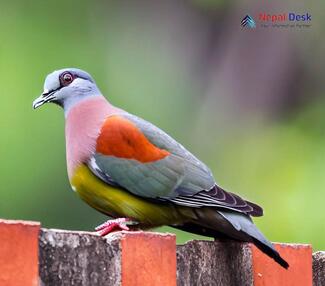Nepalonians and bird enthusiasts rejoice at the captivating sight of the Ashy-headed Green Pigeon. This fascinating bird species is native to Nepal and surrounding regions, providing an enchanting addition to the area's diverse wildlife scene. As an essential component of local ecosystems, the Ashy-headed Green Pigeon contributes to maintaining overall environmental health. Let's explore more about this beguiling bird, its habitat, diet, and behavioral characteristics.
Natural Habitat And Distribution
Nestled amidst the richly diverse landscapes of Nepal, the Ashy-headed Green Pigeon (Treron phayrei) thrives in mixed deciduous forests. These birds often favor locations near rivers, water sources, and dense canopies for protection from predators. In addition to Nepal, their range extends across south-eastern Bangladesh, northeastern India, western Myanmar, and southern China.
Distinctive Physical Features
Easily distinguished by its ashy-grey head and neck, the Ashy-headed Green Pigeon presents a striking contrast against its primarily green plumage. This medium-sized pigeon has a sturdy build with short legs and a powerful bill ideal for its diet of fruits and seeds. Adult males exhibit distinctive purple shoulder patches, while females display blueish-grey coloring.
Diet And Feeding Habits
A frugivorous species by nature, these pigeons mainly feed on wild fruits such as figs and berries found throughout their natural habitat. They also consume small seeds and occasional insects as supplements to their fruit-based diet. Generally adopting an arboreal lifestyle, they spend much of their time foraging in tree canopies.
Breeding And Social Behaviors
The breeding season for Ashy-headed Green Pigeons usually occurs between April through August each year. The male engages in courtship displays that include flapping wings, strutting, and cooing. The ensuing monogamous pairs work together in constructing a small, delicate nest in dense foliage. Female pigeons lay one or two eggs which the couple diligently incubates together for about two weeks. Hatchlings are cared for by both parents, who share responsibilities such as feeding and protecting their young until they fledge.
Conservation Status And Threats
Currently classified as "Least Concern" by the IUCN Red List of Threatened Species, the Ashy-headed Green Pigeon faces no immediate extinction threat. However, rapid deforestation poses significant challenges to their survival, as it leads to habitat loss and fragmentation. Environmental awareness and conservation efforts that focus on preserving native forests will be crucial in ensuring the continued existence of this captivating species.
In conclusion, the Ashy-headed Green Pigeon contributes significantly to Nepal's rich biodiversity. By learning about their unique characteristics, habitat preferences, diet, and behaviors, we can help protect these birds' essential role within the ecosystem. Preserving their environment will not only benefit these avian wonders but create a thriving ecosystem for generations to come.

